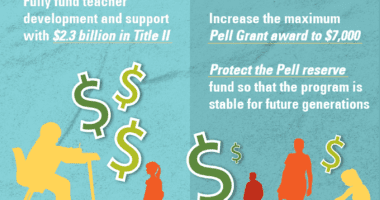PISA Headlines Are More Complicated Than They Seem
Over the past week, we’ve seen two big headlines emerge about the 2015 Programme for International Student Assessment (PISA) results. One focuses on declines in U.S. math scores, and how our students, on average, compare with teens in other countries. The other celebrates U.S. improvement on equity measures in science. But a closer look at the data — including results for students of both low and high socioeconomic status (SES) over time — shows that both stories are a bit more complicated.
When it comes to results in science, there is reason to celebrate — with caution. Scores for low-SES students increased by about 22 points between 2006 and 2015. According to PISA, that’s more than two-thirds of a school year’s worth of knowledge — a substantial amount. But here’s the thing: Much of that improvement happened before 2012, not since then. In fact, it’s likely that a lot of that improvement happened before 2009, the year that the U.S. overall science scores peaked (2009 science results for low-SES students aren’t available publicly). Since 2012, scores of low-SES students did improve, but only by 1 point. In other words, while we have made some gains for low-SES students, our improvement has actually slowed down in recent years.
In reading, the story is similar, although difficult to confirm since we don’t have comparable data by student SES status prior to 2009. Here’s what we do know though: Between 2009 and 2012, U.S. scores for low-SES students improved by 9 points, followed by just a 1-point increase in 2015.
It’s important to note, too, that in both science and reading, results for high-SES students have been on the decline. Thus, the fact that gaps in achievement look smaller today than they did in 2006 and 2009 (in science and reading, respectively) is not entirely good news.
Unlike results in science and reading, math scores offer no reason for celebration. Our average results today are lower than they’ve been at any point since 2003. Since 2012, results declined for students across the socioeconomic spectrum. In fact, while in 2012, results for our low-SES students were about 10 points higher than they had been in 2003, those gains have disappeared. Results for high-SES students, in the meantime, are far lower than they were 12 years ago.
The only potential comfort here is that when it comes to math trends, OECD average results have also declined, both since 2012 and since 2003, albeit not as much as those of the United States. As a result, our (already dismal) overall ranking among OECD countries has not dropped as much as the decline in our own results might suggest. In 2012, only 5 out of 34 OECD countries performed significantly worse than the U.S. in math; in 2015, 4 out of 35 did so. Again, not a reason for celebration, by any means.
All in all, we clearly have work to do.
For more Ed Trust analysis of the 2015 PISA results, take a look at our slides.












